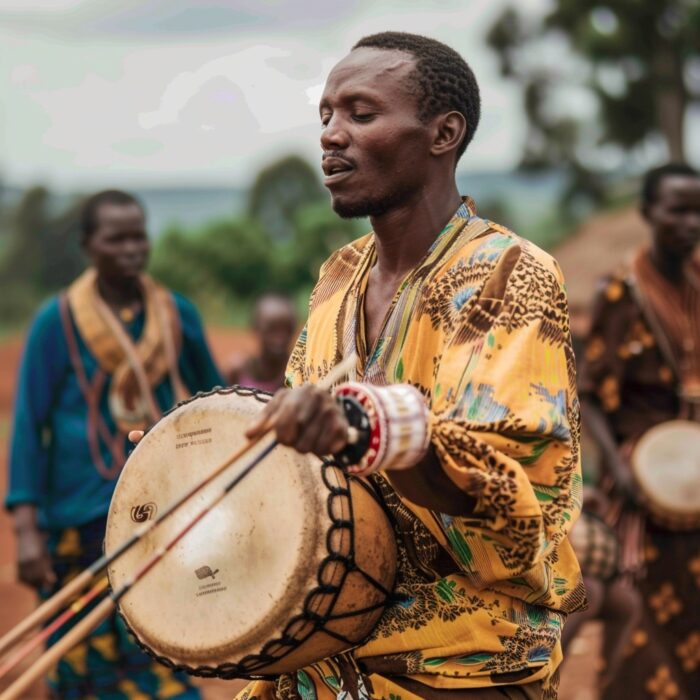In the heart of East Africa, Burundi is distinguished by a musical tradition that transcends time. To the rhythm of ancestral drums and songs, Burundian music is a source of expression, a vector of cultural values, and a unifying element of the nation. This article explores the wealth of instruments, styles and occasions in which traditional music accompanies the lives of Burundians.
Les Tambours Royaux: The heart of tradition
- Ingoma The drum, called Ingoma in Kirundi, is the central instrument of traditional Burundian music. Carved from a tree trunk, it is covered with skins and comes in different sizes, depending on its musical role.
- Les Tambours Sacrés: The most important drums, including the famous Karyenda, are symbols of Burundi's ancestral unity and royalty.
- The Master Drums Tambours Royaux ensembles are historically made up of recognized specialists. Their rigorous training combines musical dexterity with the transmission of traditional knowledge.
Instruments, songs and dances
- Percussion instruments: In addition to the Ingomas, other rhythm instruments include the Umuduri (percussion calabash) and the Inzogera (bells attached to the dancers' ankles).
- Melodic instruments: Less common, stringed instruments (Inanga, zither) or wind instruments (Ikimbe, a kind of flute) can accompany the singing.
- Polyphonic songs Burundian musical tradition is strongly vocal, with harmonized styles of collective singing. These include the Imvyino (welcome song) and the Indirimbo (praise song, often dedicated to heroes).
- The Dances Many dances are associated with traditional songs and rhythms, often depicting scenes from daily life or expressing cultural values.
Burundian Music in Daily Life and on Special Occasions
- Social Life Music gives rhythm to everyday life, accompanying farm work, family celebrations or simply moments of conviviality.
- National holidays Burundi drums are a major component of festivities such as Independence Day, highlighting the country's heritage and identity.
- Rites and ceremonies : Certain rituals, or key stages in life (births, weddings), are associated with specific traditional music and song.
Preservation and Evolution of Burundian Music
- Threats Modernization, rural exodus and the influence of international musical styles can threaten the transmission of certain musical traditions.
- Safeguarding initiatives Efforts are being made to document, teach and revitalize Burundi's musical heritage. Performances, training courses and musical collaborations seek to keep this tradition alive.
- Influences and Innovations Some Burundian artists integrate traditional instruments or rhythms into modern creations, demonstrating the constant evolution and reappropriation of this ancestral art.
Burundi's Traditional Clubs and Groups: Guardians of Tradition
Traditional music in Burundi is not only a living expression, but also an element passed on by clubs and groups who play a crucial role in its preservation and dissemination. These ensembles, made up of passionate and talented musicians, are dedicated to practicing, teaching and promoting this rich cultural heritage.
Royal Drum Clubs
- Abatimbo: This club, based in Gitega, is one of the oldest and most renowned in Burundi. They are renowned for their mastery of royal drums and their spectacular performances at official ceremonies and cultural festivals.
Role of Traditional Clubs and Groups
- Heritage preservation: These ensembles play an essential role in preserving and transmitting Burundi's ancestral musical traditions.
- Education and Training: They train young talent, perpetuating traditional musical knowledge and techniques.
- Promotion and Distribution: They contribute to the dissemination of traditional Burundian music on the national and international scene, taking part in festivals and tours.
Importance of Backup
- Support for Clubs and Groups: It is crucial to support these ensembles through funding, performance opportunities and cultural exchange programs.
- Youth involvement: Encouraging younger generations to get involved in traditional music is essential for its long-term survival.
- Raising public awareness: Promoting the value of Burundian traditional music to the general public and cultural institutions is necessary for its recognition and preservation.
In a nutshell
Traditional Burundian music is a vibrant expression of the country's culture and history. It unites generations, tells epics, and gives rhythm to the lives of Burundians. Efforts to preserve and perpetuate it are crucial to ensure the longevity of this heritage jewel.


No Title
Find the perfect AI tools to streamline your workflow and boost productivity.
✨ https://top-ai-directory.com ✨
Uncover practical AI applications to optimize your processes.
Sincerely,
Felipe Gil